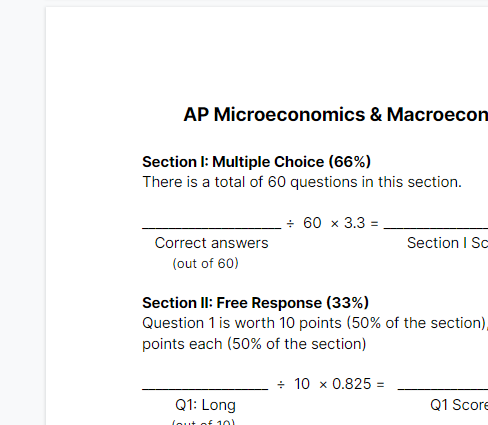Generally speaking, both Advanced Placement Calculus courses and exams are designed to be college-level calculus courses, with Pre-Calculus prerequisite. Both courses will give you opportunities for college credit. Both courses require students to profoundly understand and master calculus concepts, but BC will conduct an in-depth investigation on the calculation and application of calculus. Furthermore, BC Calculus introduces two new concepts: Parametric Equations, Polar Coordinates, and Vector-Valued Functions; as well as Infinite Sequences and Series
AP Class Details
They are both college-level calculus courses offered by the College Board. While both courses cover calculus, there are some differences in the content and depth of the material covered.
AP Calculus AB
Overall, this course covers topics such as limits and continuity, derivatives and their applications, integrals and their applications, and differential equations. This course provides a solid foundation in calculus and prepares students for further study in mathematics, engineering, and science.
- Limits and Continuity
- Differentiation: Definition and Fundamental Properties
- Differentiation: Composite, Implicit, and Inverse Functions
- Contextual Applications of Differentiation
- Analytical Applications of Differentiation
- Integration and Accumulation of Change
- Differential Equations
- Applications of Integration
AP Calculus BC
This course covers all of the topics covered in AP Calculus AB and additional topics such as sequences and series, parametric equations, and polar coordinates. The course also includes an introduction to differential equations and vectors.
This is a more advanced course, typically taken by students with a strong interest in mathematics, engineering, or physics.
- Limits and Continuity
- Differentiation: Definition and Fundamental Properties
- Differentiation: Composite, Implicit, and Inverse Functions
- Contextual Applications of Differentiation
- Analytical Applications of Differentiation
- Integration and Accumulation of Change
- Differential Equations
- Applications of Integration
- Parametric Equations, Polar Coordinates, and Vector-Valued Functions
- Infinite Sequences and Series
AP Exam Details
AP Calculus AB
The exam is split into two sections: multiple choice and free response.
The multiple choice section consists of 45 questions and students have 1 hour and 45 minutes to complete it.
The free response section consists of 6 questions and students have 1 hour and 30 minutes to complete it. The exam covers limits and continuity, derivatives, integrals, applications of derivatives and integrals, and differential equations. Students are expected to have a solid understanding of these topics and the ability to apply calculus concepts to solve problems.
To succeed in this exam, students should have a strong foundation in algebra, geometry, and trigonometry, as these concepts are fundamental to calculus. They should also be able to read and interpret graphs, understand mathematical notation, and solve problems using various methods. Additionally, students should be able to identify and apply appropriate calculus concepts to real-world problems and communicate their solutions effectively using mathematical notation and language.
AP Calculus BC
This exam is split into multiple-choice and free-response. The multiple-choice section consists of 45 questions and students have 1 hour and 45 minutes to complete it. The free-response section consists of 6 questions and students have 1 hour and 30 minutes to complete it.
The exam covers limits and continuity, derivatives, integrals, applications of derivatives and integrals, differential equations, parametric equations and polar coordinates, infinite sequences and series, and vector calculus. Students are expected to have a solid understanding of these topics and the ability to apply calculus concepts to solve problems.
To succeed in the AP Calculus BC exam, students should have a strong foundation in algebra, geometry, trigonometry, and single-variable calculus. They should also be able to read and interpret complex graphs, understand mathematical notation, and solve problems using various methods. Additionally, students should be able to identify and apply appropriate calculus concepts to real-world problems and communicate their solutions effectively using mathematical notation and language.
Students can use graphing calculators on both AB and BC exams. Below is the list of approved graphic calculators for the year 2022-2023:
Casio
| FX-6000 Series | FX-6200 Series | FX-6300 Series |
| FX-6500 Series | FX-7000 Series | FX-7300 Series |
| FX-7400 Series | FX-7500 Series | FX-7700 Series |
| FX-7800 Series | FX-8000 Series | FX-8500 Series |
| FX-8700 Series | FX-8800 Series | Graph25 Series |
| FX-9700 Series* | FX-9750 Series* | FX-9860 Series* |
| CFX-9800 Series* | CFX-9850 Series* | CFX-9950 Series* |
| CFX-9970 Series* | FX 1.0 Series* | FX-CG-10 * |
| Algebra FX 2.0 Series* | FX-CG-20 Series* | FX-CG-50* |
| Graph35 Series* | Graph75 Series* | Graph95 Series* |
| Graph100 Series* | FX-CG500* (The use of the stylus is not permitted) |
Hewlett-Packard
| HP-9G | HP-28 Series* | HP-38G* |
| HP-39 Series* | HP-40 Series* | HP-48 Series* |
| HP-49 Series* | HP-50 Series* | HP Prime* |
Radio Shack
| EC-4033 | EC-4034 | EC-4037 |
Sharp
| EL-5200 | EL-9200 Series* | EL-9300 Series* |
| EL-9600 Series* (The use of the stylus is not permitted) | EL-9900 Series* |
Texas Instruments
| TI-73 | TI-80 | TI-81 |
| TI-82* | TI-83* | TI-83 Plus* |
| TI-83 Plus Silver* | TI-84 Plus* | TI-84 Plus CE* |
| TI-84 Plus CE Python* | TI-84 Plus Silver* | TI-84 Plus C Silver* |
| TI-84 Plus T* | TI-84 Plus CE-T* | TI-84 Plus CE-T Python Edition* |
| TI-85* | TI-86* | TI-89* |
| TI-89 Titanium* | TI-Nspire* | TI-Nspire CX* |
| TI-Nspire CAS* | TI-Nspire CX CAS* | TI-Nspire CM-C* |
| TI-Nspire CM-C CAS* | TI-Nspire CX-C CAS* | TI-Nspire CX II* |
| TI-Nspire CX II-T* | TI-Nspire CX II CAS* | TI-Nspire CX II-T CAS* |
| TI-Nspire CX II-C CAS* |
Other
| Datexx DS-883 | Micronta | NumWorks* |
| Smart2 |
Differences between the two exams
The difficulty of the AP Exam
In high school, the AP Calc BC exam is more difficult than the AP Calc AB exam because there is more content covered in the exam. Calculus AB covers about two-thirds of the first two semesters of calculus course content at American universities. Generally, Calculus AB test-takers will begin with the second-semester Calculus II class when they enter university. Calculus BC is equivalent to the first and second semesters of calculus at an American university. Calculus BC test-takers will usually begin with the third-semester Calculus III / Multivariable Calculus math class when they enter university.
The difficulty of the tests also reflects the credit transfer of universities. For example, MIT recognizes AP Calc BC scores, and students accepted to MIT normally receive 5 points on the BC test.
Course Pace
The content for AP Calc AB takes up a full year of study. In the meantime, AP Calc BC usually covers everything in Calculus AB in the first semester, then additional topics during the second semester. The examination times of Calculus AB and Calculus BC overlap, so within one year, students can only choose either AB or BC.
Student preferences and needs
For students who’re planning to major in biology, chemistry, physics, mathematics, computer science, or engineering in college, AP Calculus BC is a good choice. Students with a strong mathematical foundation and are looking to major in STEM fields should considering taking AP Calc BC. If you don’t have a strong mathematical foundation or are planning to major in liberal arts, take AP Calculus AB. If you take AP Calc AB, you will still gain a calculus background that will help set you up for college math.
Comparison of the AP score ratio
Below is a table showing the score distribution of the two exams in 2022. According to College Board’s data, the 5-point rate of AP Calc BC is as high as 38.3%%, while AB is only 17.6%.
Subject | 5 points | 4 points | 3 points | 2 minutes | 1 point |
AP Cal AB | 20.4% | 16.1% | 19.3% | 22.6% | 21.7% |
AP Cal BC | 41.2% | 15.6% | 20.1% | 16.4% | 6.8% |
For the 2022 exams, the pass rate for AP Calculus AB was 65.8%, while the pass rate for AP Calculus BC was 76.9%. Students who pass the AP Calculus BC exam may be eligible for more college credit or advanced placement than students who only pass the AP Calculus AB exam. The AP Calculus BC exam covers a broader range of topics and is generally considered a more advanced course.
How to choose between those two?
In the following situations, you should choose AP Calc BC:
- You are confident about your math.
- You have studied and got good grades in math courses such as Pre-Calculus.
- You plan to major in biology, chemistry, physics, mathematics, computer science, or engineering, or other related subjects in the future.
In the following situations, you should choose AP Calc AB:
- You are less confident about your math level.
- You want a more flexible schedule and save enough homework time for other AP subjects.
- You want to major in liberal arts subjects in the future that don’t require a high level of understanding of mathematics.
However, it’s important to remember that each student’s situation is unique. The decision to take AP Calculus AB or BC should be based on individual factors such as mathematical ability, interest, and future goals. It’s also important to consult with your high school math teacher or guidance counselor to get their advice on which course best fits you.
Introducing Aralia Test Preparation Bootcamp, where students can excel in standardized tests with our comprehensive approach. At Aralia, we prioritize maximizing study efficiency and accelerating score improvement through a combination of practice examinations, expert strategies, and personalized guidance. Our Bootcamp offers students the opportunity to achieve significant score improvements within a condensed timeframe by learning strategic approaches tailored to their individual needs. With instructors who are AP readers, students benefit from expert teaching and gain valuable insights into exam techniques. Furthermore, our program equips students with versatile skills and strategies that can be applied to a range of standardized tests, ensuring they are well-prepared to adapt to various exam types.

FREE AP Scoring Worksheet
With the scoring worksheet, you will be able to calculate your target score in preparation for the upcoming exam in May. We also have a full scoring worksheet available below if you want to print it out and keep it in your folder.










